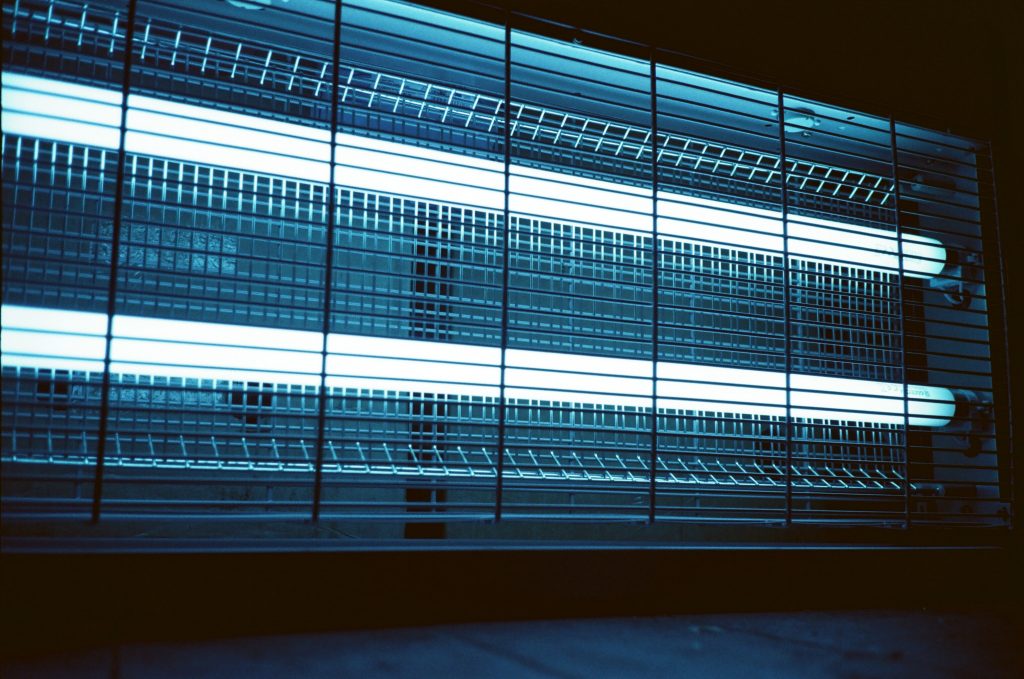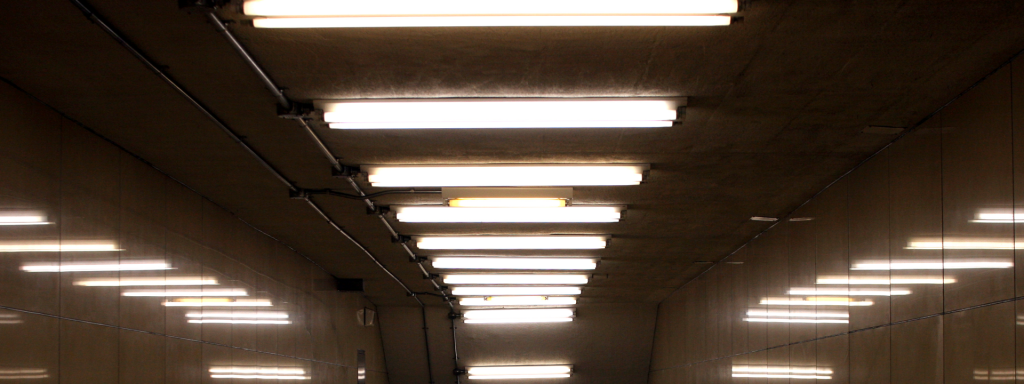The composition of the starter
The composition of the starter can be divided into: glass bulb filled with neon gas, static contact piece, and moving contact piece. The contact piece is bimetal.
The working principle of starter
The working principle is: when the switch is on, the power supply voltage is immediately added to the two poles of the starter through the ballast and the lamp filament. The voltage of 220 V immediately ionizes the inert gas of the starter and produces glow discharge.
The heat of this process makes the bimetallic piece expand. Because the expansion degree of the moving and static contact pieces is different, the U-shaped moving contact piece expands and elongates, and contacts with the static contact piece to connect the circuit, so the two poles of the ballast contact. The current passes through the ballast, the starter contact and the two ends of the filament to form a path. At this time, because the two poles of the starter are closed and the voltage between the two poles is zero, the neon gas in the starter stops conducting and the glow discharge disappears, resulting in the temperature drop in the tube, the U-shaped moving contact is cooled and contracted, the two contacts are separated, and the circuit is automatically disconnected.
At the moment when the two poles are disconnected, the circuit current is suddenly cut off, and the ballast generates a large self induced electromotive force, which acts on both ends of the tube after superposition with the power supply voltage. When the filament is heated, a large number of electrons are emitted. Under the action of high voltage at both ends of the lamp, they move from the low potential end to the high potential end at a great speed. In the process of acceleration, the argon molecules in the tube are collided and ionized rapidly. Argon is ionized to generate heat, which makes mercury produce vapor, and then mercury vapor is ionized and emits intense ultraviolet light.
Under the excitation of ultraviolet light, the phosphor inside the tube wall emits almost white visible light. After the fluorescent lamp of the library lights up normally. Because the alternating current continuously passes through the coil of the ballast, the self induced electromotive force is generated in the coil, and the self induced electromotive force hinders the current change in the coil. At this time, the ballast plays the role of reducing voltage and limiting current, so that the current is stable in the rated current range of the lamp, and the voltage at both ends of the lamp is also stable in the rated working voltage range.
Because this voltage is lower than the ionization voltage of the starter, the starter connected in parallel at both ends will no longer work. There is also a capacitor in the starter, which is in parallel with the neon bubble. Its function is to absorb the harmonic generated by glow discharge, so as not to affect the normal operation of TV, radio, audio, mobile phone and other equipment. It can also make the moving and static contacts not produce sparks when they are separated, so as to avoid burning the contacts. Without the capacitor, the starter can also work.
Other components of fluorescent lamp
Tube
Filament, tube filled with argon and thin mercury vapor, tube wall with phosphor, according to the different gas phosphor emit different colors of light.
Ballast
Ballast
A coil with an iron core has a large self-inductance. To make the gas in the tube conductive, a voltage much higher than 220V is required. Therefore, the fluorescent tube needs a much higher instantaneous voltage than the power supply voltage when lighting. When the fluorescent tube lights up normally, the resistance of the tube becomes very small, and only a small current is allowed to pass. If the current is too strong, the tube will be burned out, and the voltage applied to the tube must be lower than Power supply voltage, these two requirements are achieved by ballasts connected in series with the lamp.
Why does the starter in the fluorescent lamp need a capacitor in parallel
(1) The function of the capacitor in the starter: instantaneously increase the voltage so that the current can break down the neon gas in the tube to form a path for the tube. The capacitor is used for charging and discharging.
(2) The principle of the starter capacitor: charge when it is on, discharge when the starter is off, and break down the neon gas in the tube. If the starter is removed when the lamp is on, the lamp will not go out, because the lamp The neon gas in the tube has been broken down and formed a path.
Details: When the switch is turned on, the power supply voltage is immediately applied to the two poles of the starter through the ballast and the lamp filament. The voltage of 220 volts immediately ionizes the inert gas of the starter, generating glow discharge. The heat of the glow discharge causes the bimetallic sheet to be heated and expand, and the two poles are in contact. The current passes through the ballast, the starter contact and the filaments at both ends to form a path. The filament is quickly heated by the current and emits a lot of electrons. At this time, because the two poles of the starter are closed, the voltage between the two poles is zero, the glow discharge disappears, and the temperature in the tube decreases; the bimetallic plate automatically resets and the two poles are disconnected. At the moment when the two poles are disconnected, the circuit current is suddenly cut off, and the ballast generates a large self-induced electromotive force, which acts on both ends of the tube after being superimposed with the power supply voltage. The large amount of electrons emitted when the filament is heated moves from the low potential end to the high potential end at a great speed under the action of the high voltage at both ends of the lamp tube. In the process of acceleration, it collides with argon molecules in the tube, causing them to rapidly ionize. Argon ionization generates heat, and the heat causes mercury to generate vapor, and then the mercury vapor is also ionized and emits strong ultraviolet rays. Under the excitation of ultraviolet rays, the phosphor in the tube wall emits almost white visible light.
After the fluorescent lamp glows normally. Since the alternating current continuously passes through the coil of the ballast, self-induced electromotive force is generated in the coil, and the self-induced electromotive force hinders the current change in the coil. At this time, the ballast acts as a step-down and current-limiting function to stabilize the current within the rated current range of the lamp Inside, the voltage across the lamp tube is also stable within the rated operating voltage range. Since this voltage is lower than the ionization voltage of the starter, the starters connected in parallel at both ends no longer work.
What is a gas lamp
The gas lamp seals the discharge process between the electrodes in a bulb, so it is also called a sealed arc discharge light source. It has the characteristics of stable radiation, high power and high luminous efficiency. Therefore, it plays an important role in lighting, photometry and spectroscopy. There are many types of gas lamps. The lamps can be filled with different gases or metal vapors, such as argon, neon, hydrogen, helium, xenon and other gases and mercury, sodium, metal halides, etc., thereby forming a variety of lamp sources with different discharge media.
Working principle of gas lamp
There are always some charged particles in the lamp tube, which move and accelerate to the corresponding electrode under the action of the electric field. The accelerated particles hit the gas molecules in the tube to ionize them, thereby increasing the free charge in the tube. Some of them reach and hit the electrode, ejecting secondary electrons sufficient to excite the gas to emit light from the electrode; while the other part interacts with the gas molecules during their movement. They collide, or ionize them, or excite them to emit light, thus forming a glow discharge.
Types of gas lamps
When filled with the same material, a variety of gas lamps can be constructed due to different structures. For example, mercury lamps can be divided into: low-pressure mercury lamps, the pressure in the tube is less than 0.8Pa, it can be divided into cold cathode glow discharge type and hot cathode arc discharge type two types. High-pressure mercury lamp, the pressure in the tube is about 1 to 5 atmospheres, the luminous efficiency of the lamp can reach 40-50lm/W. Ultra-high pressure mercury lamp, the pressure in the tube can reach 10 to 200 atmospheres. Another example is the long arc and short arc in neon lamps. They all have their own luminous efficiency, luminous intensity, spectral characteristics, starting circuit, and specific structure.
What are the disadvantages of fluorescent lamps
Disadvantage 1: large volume, can only be used for basic lighting
Fluorescent lamps must have a certain length of tube diameter due to its light-emitting principle. Therefore, the volume of the lamp body is relatively large, and the design of the lamp is difficult. Generally, it can only be used for basic lighting and cannot be used for accent lighting.
Disadvantage 2: general color rendering
The display index of fluorescent lamps is good or bad, and its color rendering is based on the type of phosphor. If the phosphor in the lamp is a five-primary color phosphor, the display index can reach 90+ (but the price will be relatively more expensive).
Disadvantage 3: Dimming is more difficult
Fluorescent lamps can be dimmed, but the control technology is much more complicated than that of incandescent lamps and requires special drive appliances.
Disadvantage 4: Strobe
This is the more deadly point of fluorescent lights-strobe. Of course, as long as the gas discharge lamp has the stroboscopic phenomenon, this is caused by the periodic change of the current.
Disadvantage 5: electromagnetic interference
Due to the existence of electrical appliances in the gas discharge lamp, there will be some more or less electromagnetic interference phenomena. In some occasions that require the use of non-electromagnetic interference products, such as recording studios, operating rooms, etc., fluorescent lights are not suitable for use.
What are the advantages of fluorescent lamps
Advantage 1: High light efficiency
The luminous efficiency of fluorescent lamps is very high, up to 104 lumens per watt. When you need higher ambient illuminance, you can choose this kind of light source with higher efficiency.
Advantage 2: high lumen maintenance rate, low light decay
Assuming that the lifetime accumulation of fluorescent lamps has reached 8000 hours, some high-quality fluorescent lamps can still maintain more than 90% of the luminous flux output; even if the quality is a little bit worse, they can reach 80% of the luminous flux output. Neither incandescent lamps nor halogen lamps can do this.
Advantage 3: A variety of color temperatures are available
Fluorescent lamps generally have 4 common white colors: warm white (3000k), white (3500k), cool white (4000k), and daylight (6500k). These different color temperatures depend on the different colors of phosphors on the tube wall.



